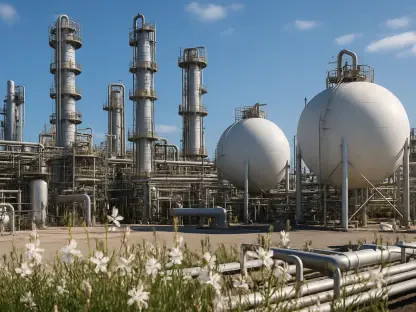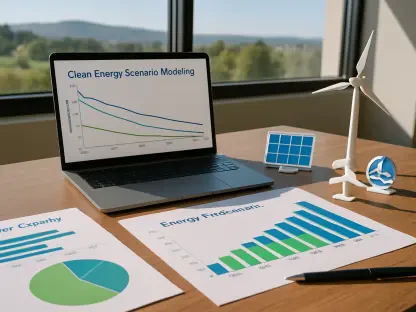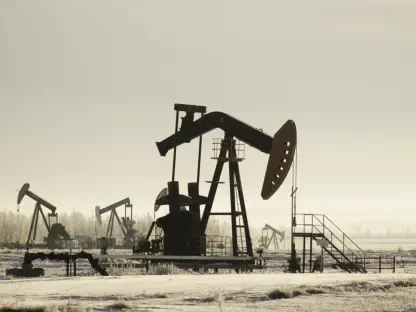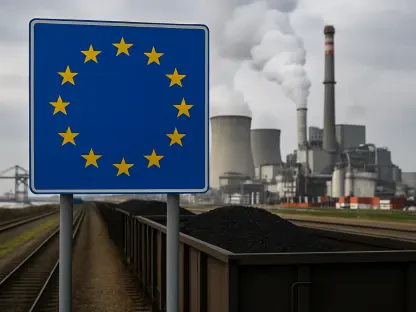California stands as a beacon of environmental progress, championing aggressive policies to achieve carbon neutrality and combat climate change with unwavering determination. At the heart of this mission is the promotion of biodiesel, particularly renewable diesel crafted from plant oils and animal fats, positioned as a cleaner substitute for traditional petroleum diesel. With nearly half of the state’s diesel fuel now classified as renewable, the shift appears promising on the surface. However, as California accelerates its green agenda, a critical question emerges about the sustainability of biodiesel when scrutinized through the lens of resource demands, production scalability, and broader environmental impacts. This exploration delves into whether this alternative fuel can truly support the state’s ambitious goals or if it merely shifts the burden elsewhere, masking deeper challenges in the pursuit of a greener future.
Diesel’s Critical Role in California’s Economy
Diesel fuel remains a cornerstone of California’s economic engine, particularly in the agricultural sector where it powers the heavy machinery essential for farming operations. Roughly 10 percent of the state’s diesel consumption is tied to agriculture, though some suggest this figure might underrepresent the true dependency. The efficiency and robustness of diesel technology make it indispensable for tasks that demand significant power and endurance, a reality often emphasized in discussions about the challenges of moving away from traditional fuels. This deep-rooted reliance underscores why transitioning to alternatives like biodiesel is both a pressing priority and a formidable obstacle in aligning with California’s environmental targets. Without addressing this fundamental need, any shift risks disrupting key industries that sustain the state’s economy.
Beyond agriculture, diesel’s role extends to transportation and construction, sectors that also lean heavily on its unmatched capacity for heavy-duty applications. The notion of completely phasing out diesel in favor of electric or other alternatives remains distant for these industries due to technological and practical limitations. Educational content, such as videos exploring the future of diesel technology, often highlights that no current substitute matches its performance for large-scale operations. This reality places biodiesel in a critical position as a potential bridge, yet it also raises the stakes for ensuring that such a transition does not compromise economic stability or operational efficiency in California’s diverse landscape.
Unpacking Renewable Diesel Production
A significant portion of California’s diesel landscape has shifted, with 48 percent of the 3.35 billion gallons produced in the 12 months ending September this year classified as renewable diesel, sourced from materials like soybean oil, canola oil, and animal fats. This statistic reflects a bold step toward reducing carbon emissions, aligning with the state’s green objectives. However, the precise composition of these renewable fuels remains shrouded in ambiguity, as state bodies such as the California Energy Commission provide limited clarity on feedstock breakdowns. This opacity hinders a full understanding of the environmental benefits claimed by renewable diesel and sparks concerns about whether the fuel’s production aligns with sustainability principles at its core.
The lack of transparency in renewable diesel production also stifles informed public discourse and policy-making, leaving stakeholders grappling with incomplete data. Without accessible information on whether the majority of the fuel comes from soybean oil, animal fats, or other sources, assessing its true ecological footprint becomes challenging. Critics argue that this gap undermines trust in California’s energy strategies, calling for greater accountability from regulatory agencies. Until clearer data emerges, doubts persist about whether the state’s push for renewable diesel genuinely advances environmental goals or merely offers a superficial solution to a complex problem, complicating the narrative of progress.
The Scalability Hurdle of Biodiesel
Scaling biodiesel production to meet California’s diesel demands reveals a daunting barrier: the sheer amount of land required for feedstock cultivation. For instance, producing just 20 percent of the state’s diesel needs from soybean oil would necessitate approximately 14,000 square miles of farmland, equivalent to 8.9 million acres. When compared to the current U.S. soybean cultivation of 85 million acres, it becomes evident that existing agricultural capacity falls short if biodiesel mandates were to expand across the nation. This raises a pressing concern about where the additional land and resources would be sourced to fulfill the remaining demand, highlighting a critical tension between fuel production and other land-use priorities.
Moreover, the scalability challenge extends beyond California’s borders, as a national shift to biodiesel would demand exponentially more resources. Estimates suggest that covering just 20 percent of U.S. diesel consumption with biodiesel could require up to 192,000 square miles of farmland, an area that competes directly with food production and natural ecosystems. This competition poses risks to food security and biodiversity, forcing a reevaluation of whether biodiesel can realistically serve as a widespread solution. The numbers paint a sobering picture, suggesting that without significant innovation in production methods or alternative feedstocks, the dream of a biodiesel-driven future may remain out of reach for large-scale implementation.
Ethical and Environmental Contradictions
California’s environmental ambitions are not without their paradoxes, particularly when it comes to the concept of emissions leakage. While the state strives to lower in-state greenhouse gas emissions, it imports 77 percent of its crude oil from regions with minimal environmental or labor protections. A similar pattern emerges with biodiesel feedstocks like palm oil and tallow, often sourced from areas linked to deforestation and other ecological damage. This practice of outsourcing environmental burdens while touting domestic progress undermines the integrity of California’s carbon-neutral claims and casts doubt on the holistic sustainability of its green initiatives.
This leakage phenomenon also introduces an ethical dimension to the biodiesel debate, questioning the fairness of achieving local environmental gains at the expense of global ecosystems. Importing feedstocks from regions with lax regulations suggests a double standard, where California’s stringent domestic policies contrast sharply with its reliance on less regulated foreign supplies. Such contradictions erode the moral foundation of the state’s environmental leadership, prompting a need for policies that address the full lifecycle impacts of biodiesel. Until these global repercussions are accounted for, the true environmental benefit of renewable diesel remains uncertain, challenging the narrative of a seamless green transition.
Biodiesel’s Long-Term Prospects
Looking ahead, the long-term viability of biodiesel as a sustainable replacement for petroleum diesel faces significant scrutiny due to current limitations in production capacity and environmental impact. The immense scale required to fully transition, especially for heavy-duty sectors where electric alternatives are not yet feasible, stretches beyond existing resources and infrastructure. While biodiesel may reduce emissions in certain contexts, its hidden costs—such as competition with food production and the strain on land resources—suggest it might be more of a temporary measure than a definitive solution for California’s energy future.
Technological optimism exists, with potential advancements in biofuel production or alternative energy sources on the horizon, yet the reality remains grounded in present constraints. Heavy machinery and industrial applications are likely to depend on diesel technology for the foreseeable future, necessitating a candid assessment of biodiesel’s shortcomings. Rather than viewing it as a complete answer, policymakers might consider biodiesel as part of a broader mix of strategies, complemented by innovations in efficiency and electrification where possible. This balanced approach could mitigate some of the environmental and scalability issues currently casting shadows over biodiesel’s role.
Reflecting on a Complex Journey
Reflecting on California’s push toward renewable diesel, it becomes clear that the journey is fraught with both promise and pitfalls. The state’s bold adoption of biodiesel marks a significant stride toward reducing emissions, yet the challenges of scalability, transparency, and ethical contradictions loom large. Moving forward, a critical next step involves prioritizing transparency from regulatory bodies to ensure energy policies are rooted in comprehensive data. Additionally, exploring diverse feedstocks and investing in technologies that lessen land-use conflicts could address some sustainability concerns. Ultimately, California’s experience underscores the need for a holistic strategy—one that balances immediate environmental gains with long-term global impacts, ensuring that the pursuit of carbon neutrality does not inadvertently burden other regions or resources.









